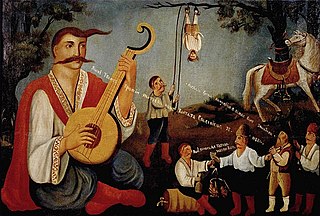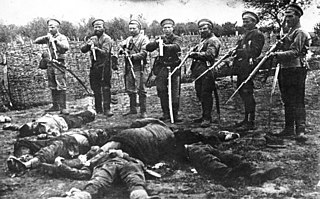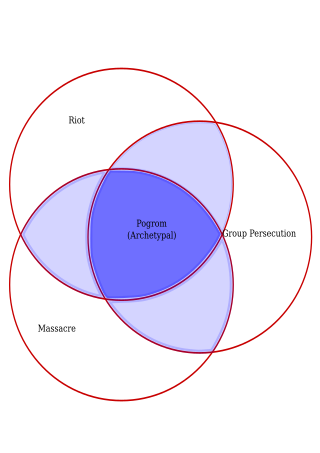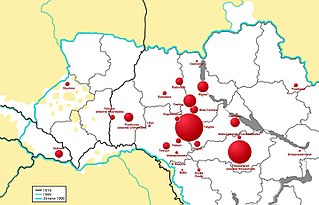
A pogrom is a violent riot incited with the aim of massacring or expelling an ethnic or religious group, particularly Jews. The term entered the English language from Russian to describe 19th- and 20th-century attacks on Jews in the Russian Empire. Retrospectively, similar attacks against Jews which occurred in other times and places also became known as pogroms. Sometimes the word is used to describe publicly sanctioned purgative attacks against non-Jewish groups. The characteristics of a pogrom vary widely, depending on the specific incident, at times leading to, or culminating in, massacres.

Anton Ivanovich Denikin was a Russian military leader who served as the acting supreme ruler of the Russian State and the commander-in-chief of the armed forces of South Russia during the Russian Civil War of 1917–1923. Previously, he was a general in the Imperial Russian Army during World War I.

Symon Vasyliovych Petliura was a Ukrainian politician and journalist. He was the Supreme Commander of the Ukrainian People's Army (UNA) and led the Ukrainian People's Republic during the Ukrainian War of Independence, a part of the wider Russian Civil War.

The Khmelnytsky Uprising, also known as the Cossack–Polish War, or the Khmelnytsky insurrection, was a Cossack rebellion that took place between 1648 and 1657 in the eastern territories of the Polish–Lithuanian Commonwealth, which led to the creation of a Cossack Hetmanate in Ukraine. Under the command of hetman Bohdan Khmelnytsky, the Zaporozhian Cossacks, allied with the Crimean Tatars and local Ukrainian peasantry, fought against Commonwealth's forces. The insurgency was accompanied by mass atrocities committed by Cossacks against prisoners of war and the civilian population, especially Poles, Jews and Roman Catholic and Ruthenian Uniate clergy, as well as savage reprisals by loyalist Jeremi Wiśniowiecki, the voivode of Ruthenian descent of the Ruthenian Voivodeship.
The persecution of Jews has been a major event in Jewish history prompting shifting waves of refugees and the formation of diaspora communities. As early as 605 BCE, Jews who lived in the Neo-Babylonian Empire were persecuted and deported. Antisemitism was also practiced by the governments of many different empires and the adherents of many different religions (Christianity), and it was also widespread in many different regions of the world.

The Koliivshchyna was a major haidamaky rebellion that broke out in Right-bank Ukraine in June 1768, caused by the dissatisfaction of peasants with the treatment of Orthodox Christians by the Bar Confederation and serfdom, as well as by hostility of Cossacks and peasants to the local Polonized Ruthenian nobility and ethnic Poles. The uprising was accompanied by pogroms against both real and imagined supporters of the Bar Confederation, particularly ethnic Poles, Jews, Roman Catholics, and especially Byzantine Catholic priests and laity. This culminated in the massacre of Uman. The number of victims is estimated from 100,000 to 200,000. Many communities of national minorities completely disappeared in the areas devastated by the uprising.

The history of the Jews in Ukraine dates back over a thousand years; Jewish communities have existed in the modern territory of Ukraine from the time of the Kievan Rus'. Important Jewish religious and cultural movements, from Hasidism to Zionism, arose there. According to the World Jewish Congress, the Jewish community in Ukraine is Europe's fourth largest and the world's 11th largest.
Plyskiv is a village in Vinnytsia Raion, Vinnytsia Oblast, Ukraine. The population is 1,439 (2006).

Ruzhyn is an urban-type settlement in Berdychiv Raion, Zhytomyr Oblast, Ukraine. Prior to the administrative reform of 2020, it served as the administrative centre of the former Ruzhyn Raion. Population: 4,209

Haisyn or Haysyn is a city in central Ukraine. It serves as the administrative center of Haisyn Raion within Vinnytsia Oblast. It is located on the Sob in the eastern part of the historical region of Podolia. Its population is 25,698.

Tetiiv or Tetiyev is a city in Bila Tserkva Raion in the Kyiv Region in Ukraine. Tetiiv has a railway station on the Southwestern Railways Koziatyn - Zhashkiv line. It hosts the administration of Tetiiv urban hromada, one of the hromadas of Ukraine. The population is 12,640. The city is located on two banks of the Roska River, into which the right tributaries of the Rosishka and Dubravka flow.

Controversies of the Polish–Soviet War, fought in 1919–20, concerning the behaviour of the military forces and crimes they committed. Each side charged the other with violations of international law in an effort to sway public opinion in the West, which was felt to be important for both sides.

The Kiev pogroms of 1919 refers to a series of anti-Jewish pogroms in various places around Kiev carried out by White Volunteer Army troops. The series of events concern the following districts:

Antisemitism in Ukraine has been a historical issue in the country, particularly in the twentieth century. The history of the Jewish community of the region dates back to the era when ancient Greek colonies existed in it. A third of the Jews of Europe previously lived in Ukraine between 1791 and 1917, within the Pale of Settlement. The large concentration of Jews in this region historically made them an easy target for anti-Jewish actions and pogroms.

The Lwów pogrom was a pogrom perpetrated by Polish soldiers and civilians against the Jewish population of the city of Lwów. It happened on 21–23 November 1918, during the Polish–Ukrainian War that followed World War I.
Pogroms in the Russian Empire were large-scale, targeted, and repeated anti-Jewish rioting that began in the 19th century. Pogroms began to occur after Imperial Russia, which previously had very few Jews, acquired territories with large Jewish populations from the Polish–Lithuanian Commonwealth and the Ottoman Empire from 1772 to 1815. These territories were designated "the Pale of Settlement" by the Imperial Russian government, within which Jews were reluctantly permitted to live. The Pale of Settlement primarily included the territories of Poland, Ukraine, Belarus, Bessarabia, Lithuania and Crimea. Jews were forbidden from moving to other parts of European Russia, unless they converted from Judaism or obtained a university diploma or first guild merchant status. Migration to the Caucasus, Siberia, the Far East or Central Asia was not restricted.

The Belostok (Białystok) pogrom occurred between 14–16 June 1906 in Białystok, Poland. During the pogrom, between 81 and 88 Jews were killed by soldiers of the Imperial Russian Army, the Black Hundreds, and about 80 people were wounded.

The White Terror in the former Russian Empire refers to the violence and mass killings carried out by the White movement during the Russian Civil War (1917–1923). It began after the Bolsheviks seized power in November 1917, and continued until the defeat of the Whites at the hands of the Red Army.

This article provides a list of definitions of the term pogrom. The term originated as a loanword from the Russian verb громи́ть, meaning "to destroy, to wreak havoc, to demolish violently". The events in Odessa during Holy Week in 1871 were the first to be widely called a "pogrom" in Russian, and the events of 1881–82 introduced the term into common usage throughout the world.

The pogroms during the Russian Civil War were a wave of mass murders of Jews, primarily in Ukraine, during the Russian Civil War. In the years 1918–1920, there were 1,500 pogroms in over 1,300 localities, in which up to 250,000 were murdered. All armed forces operating in Ukraine were involved in the killings, in particular the anti-Communist Ukrainian People's Army and Armed Forces of South Russia. It is estimated that more than a million people were affected by material losses, 50,000 to 300,000 children were orphaned, and half a million were driven out from or fled their homes.


















